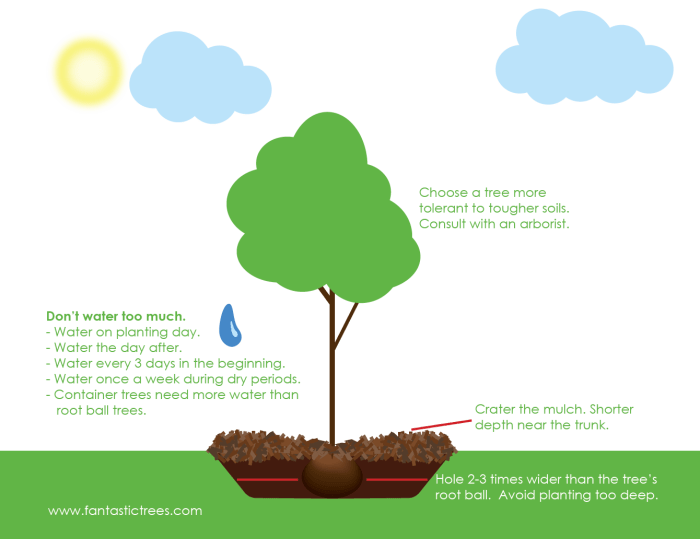Planting Techniques: Plant Tree With Burlap

Plant tree with burlap – Planting your new tree, nestled securely in its burlap container, is a rewarding experience. Follow these steps for a successful planting that ensures your tree thrives for years to come. Proper technique minimizes transplant shock and maximizes the chances of healthy growth.
The process involves careful handling of the root ball, thorough soil preparation, and appropriate watering. Remember, patience and attention to detail are key to a thriving tree.
Burlap Removal and Root System Handling
Before planting, assess the burlap. For thin, biodegradable burlap, you can often plant the tree directly, leaving the burlap in place. However, for thicker burlap, or if the burlap appears to be restricting root growth, partial or complete removal is necessary. Carefully cut away the burlap from the top and sides of the root ball, being mindful not to damage the delicate roots.
Never leave the burlap around the root ball, as it will restrict growth and potentially suffocate the roots. For stubborn burlap, gently tear it away from the root ball, avoiding sharp tugs that could harm the root system. Inspect the roots for any circling or tightly bound areas. Gently loosen these to encourage outward root growth.
Soil Preparation
Proper soil preparation is crucial for a healthy tree. The planting hole should be at least twice as wide as the root ball, and the same depth. This allows for adequate root expansion. Amend the soil with organic matter, such as compost or well-rotted manure, to improve drainage and aeration. This will enrich the soil and provide essential nutrients for healthy root development.
Avoid amending the soil with fresh manure, which can burn the roots. A good soil mixture provides optimal conditions for root establishment and future growth. For example, a blend of topsoil, compost, and perlite ensures proper drainage and aeration.
Watering Techniques for Newly Planted Trees
Watering is essential for the establishment of your newly planted tree. Several methods can be used to ensure the tree receives adequate moisture. A slow, deep watering is ideal, allowing the water to penetrate the root ball and surrounding soil thoroughly. Avoid overhead watering, which can lead to leaf diseases. A soaker hose is an excellent choice, as it delivers water directly to the roots without wetting the foliage.
Alternatively, use a watering can with a gentle rose to avoid soil erosion. Frequency of watering depends on weather conditions, soil type, and tree species. During hot, dry periods, more frequent watering may be necessary.
Backfilling and Soil Firming
After placing the tree in the hole, carefully backfill with the prepared soil mixture. Fill the hole gradually, ensuring that the root ball is completely covered and the tree is planted at the same depth it was previously growing. Avoid burying the tree too deeply, which can lead to root rot. Gently firm the soil around the root ball to eliminate air pockets and ensure good soil contact with the roots.
This provides stability for the tree and helps the roots establish themselves. Avoid compacting the soil too tightly, as this can restrict root growth. A gentle but firm approach ensures both stability and healthy root development.
Planting trees with burlap safeguards the root system during transplantation. This careful handling is especially crucial for young seedlings, contrasting with the more involved process of starting from seed, such as when learning how to plant cedar tree seeds. Understanding seed germination techniques provides a broader perspective on tree cultivation, ultimately complementing the benefits of planting established trees with burlap.
Post-Planting Care

Giving your newly planted burlap tree the best possible start is crucial for its long-term health and vibrancy. Proper post-planting care ensures the tree establishes a strong root system and thrives in its new environment. This involves a consistent watering regimen, appropriate fertilization, and strategic mulching.
Watering Frequency and Amount
Consistent watering is paramount, especially during the first year. The frequency depends on several factors including soil type, weather conditions, and tree species. Clay soils retain moisture longer than sandy soils, requiring less frequent watering. Hot, dry weather necessitates more frequent watering than cooler, humid conditions. Generally, aim for deep, infrequent watering rather than shallow, frequent watering.
This encourages deep root growth. A good rule of thumb is to water deeply enough to moisten the soil to a depth of 12-18 inches. Check soil moisture regularly by inserting your finger a few inches into the soil; if it feels dry, it’s time to water. Avoid overwatering, which can lead to root rot.
Fertilization Schedule
While newly planted trees don’t require heavy fertilization, a balanced slow-release fertilizer can provide essential nutrients to promote healthy growth. Apply a granular fertilizer according to the product instructions, typically in early spring. Avoid placing fertilizer directly against the trunk. For example, a slow-release 10-10-10 fertilizer applied at a rate of 1-2 pounds per inch of trunk diameter (measured at a height of 4.5 feet) is a good starting point.
Always follow the specific instructions on your chosen fertilizer. Avoid over-fertilizing, which can harm the tree. A soil test can help determine if additional nutrients are needed.
Mulching Practices
Mulching is beneficial for retaining soil moisture, suppressing weeds, and regulating soil temperature. Apply a 2-3 inch layer of organic mulch, such as wood chips or shredded bark, around the base of the tree, keeping it a few inches away from the trunk to prevent rot. A visual guide would show a circle of mulch surrounding the tree, clearly illustrating the appropriate distance from the trunk.
The diagram would also highlight the recommended mulch depth and type. This keeps the trunk area free of excess moisture and potential pests. Regularly replenish the mulch layer as it decomposes. For instance, replenishing the mulch layer every spring will help maintain its effectiveness.
Visual Guide of Optimal Post-Planting Care Practices, Plant tree with burlap
A visual guide would consist of three distinct panels. The first panel depicts a newly planted tree with burlap still intact, illustrating the correct planting technique (already covered in a previous section). The second panel showcases the proper watering technique: a slow, deep watering method, reaching a depth of 12-18 inches, indicated by a dotted line extending down from the soil surface.
The third panel shows a tree surrounded by a ring of mulch, clearly indicating the 2-3 inch depth and the crucial space between the mulch and the tree trunk. Arrows and labels clearly identify each element and step, providing a clear and concise visual representation of the recommended practices.
Questions and Answers
Can I reuse burlap from a previously planted tree?
No. Used burlap can harbor diseases and pests. Always use fresh burlap.
What if I accidentally damage the root ball during planting?
Gently repair any damage with soil and water thoroughly. Monitor the tree closely for signs of stress.
How long should I water a newly planted tree?
Water deeply and regularly, especially during dry spells, for the first year. The frequency will depend on your climate and soil type.
What type of burlap is best for larger trees?
Heavier-weight burlap is generally recommended for larger trees to provide better support and prevent root damage.
My tree isn’t growing well after planting. What could be wrong?
Several factors could be at play, including improper planting, insufficient watering, pest infestation, or disease. Consult a local arborist for diagnosis.
